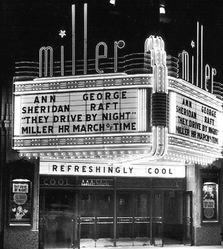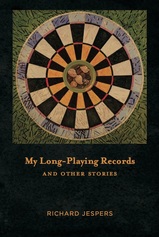A WRITER'S WIT
Poetry is the work of poets, not of peoples or communities; artistic creation can never be anything but the production of an individual mind.
Lascelles Abercrombie
Born January 9, 1881
"Tales of the Millerettes," About a Theater

In 1963, when I was in ninth grade, I went to see West Side Story at the Miller Theater, or I should say I went to see the beginning of the film. In a way that only junior high kids can concoct, my date and I got hornswoggled (a word that seems so Kansas) into attending a party shortly after the film had begun. Part of me was furious. I’d wanted to attend that movie for the longest time, and I’d paid a good bit of money to see that my date and I gained entrance for a Saturday night showing. But part of me felt deliciously wicked when we all scooted across town (on foot?) to a soiree where my date and I could make out. How this was all explained to my parents I can’t quite recall. At any rate, this fragment of history became the frame for “1970,” the third segment of my long story. I didn’t see the film again until I was well into my thirties.
To conduct research for the first third of the story, “1922,” I contacted the Wichita Public Library, and a very kind woman sent me a file folder of clippings about the Miller Theater—some from its opening week in 1922, and some from later years, 1972, when it was threatened with destruction. Fourth National Bank ultimately bought the theater and demolished it in order to erect a parking lot—a f%#@ing parking lot! The rancorous uproar that it caused may have saved its neighboring and equally venerable venue, the Orpheum, just up the street, from being destroyed. I kept rereading the clippings until this matriarchal family, the Bernards, seemed to arrive at my doorstep. Each Bernard woman is influenced by her work or involvement with the Miller Theater, her love for drama.
For the second segment of the story, “1944-48,” I used my imaginative wits to come up with a plausible narrative for the Bernard woman who actually makes the train ride to Los Angeles and builds a short career in film for herself until, like her mother, she becomes ensnared in a relationship with a man.
The greatest delight I took in writing this story may have been in recreating the Miller Theater in such a way that it almost becomes another character, like Carson McCullers’s restaurant in her novella, Ballad of the Sad Café. Not that I would rank myself next to her as a writer, but it was my honest attempt to use a sense of place to create character. And it wasn’t easy. Many a time I would put this story away, and then like a sorry garment you’re trying stitch together, I would drag the pieces out again.
Then I finally workshopped it with my writing group. Members found all kinds of problems: problems with chronology, problems with historical details, and more. So I revised it and put it away. Again. When I pulled it out for the last time, the pieces seemed to fall into place; I was finally satisfied that it might be a decent story. I sent it out—also a problem, because how many journals want to publish such a long story? But finally, the editor at Eclectica, an online journal, whose pages are endless in cyberspace, contacted me to say that he wanted it. It may be the placement that pleased me most. If you buy My Long-Playing Records and Other Stories, I hope you enjoy reading “Tales of the Millerettes” as much as I enjoyed writing it. Just be sure and set aside enough time!
READ A PASSAGE FROM THE STORY:
Opening night Mr. Miller had gathered his Millerettes on the draperied mezzanine and pointed down to the crowd queued up outside; Velma heard the murmur of voices growing. She saw one boxy limousine after another drop off yet another privileged party (the mayor and such), who were ushered in early. Those less fortunate hoofed it to the end of the line, which snaked its way around two blocks (ten thousand customers had competed for only two thousand seats). As the place opened, she watched footmen open doors to carriages, Cadillacs, and Packards. Doormen greeted theatergoers, and directors showed customers to the aisle, where she and other Millerettes would escort them to their seats. The console of an eleven-rank Wurlitzer was sunken in the orchestra pit, the squalling pipes located three stories up behind two decorative grilles. A funny little man named Shelly Hand was playing “Ain’t We Got Fun?” and it quickened Velma’s step. Mr. Hand received a score for every film and was paid to make sure he ended when the movie did. When the showing was over, he would sometimes bow to great applause (84-5).

Click here to buy a copy of My Long-Playing Records and Other Stories, where it is available at Amazon.
11/13/14 — Introduction to My Long-Playing Records
11/20/14 — "My Long-Playing Records" — The Story
11/27/14 — "A Certain Kind of Mischief"
12/04/14 — "Ghost Riders"
12/11/14 — "The Best Mud"
12/18/14 — "Handy to Some"
12/25/14 — "Blight"
01/01/15 — "A Gambler's Debt"


 RSS Feed
RSS Feed